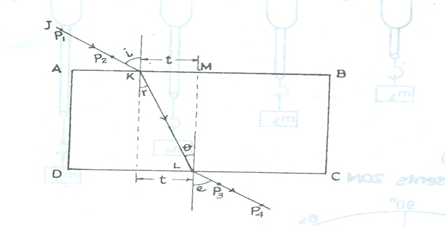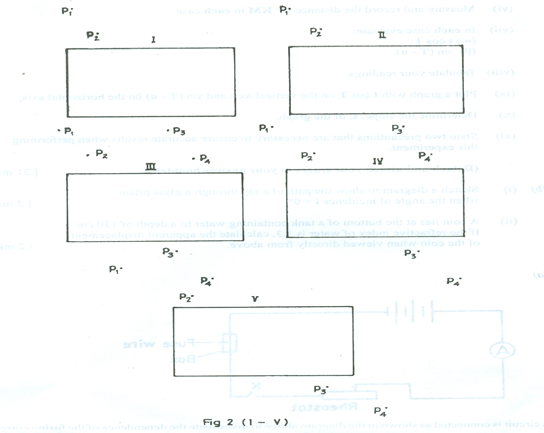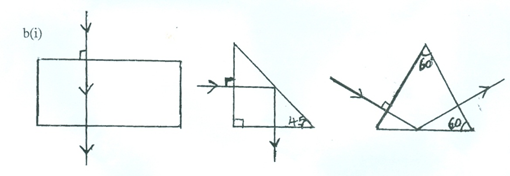Question 2A

The outline ABCD of a rectangular glass prism is traced on a drawing paper. Two pins P1 and P2 are used to trace a ray such that it makes an angle of incidencei at K on the face AB of the outline. Two others pins P3 and P4 are used to trace the path of the emergent ray through L on face DC of the prism. The points K and L are joined. A normal is drawn from L to M. The angels i,r, and e are measured and recorded
The procedure is repeated for four other values of i.
Fig. 2 (I –V) shows the outlines for the five trails.
- Trace the path of the ray through the prism in each case.
- Measure and record the angle of incidence i and the corresponding angle of emergence e in each case.
- Evaluate T = in each case.
- Also measure and record the angle of refraction r and angle of incidence in theprism in each case.
- Evaluate u = in each case
- Measure and record the distance t = KM in each case.
- In each case evaluate:
(tcosT;
(β) sin (T – u)
(viii) Tabulate your readings.
- Plot a graph with t cosT on the vertical axis and sin (T - u )on the horizontal axis.
- Determine the slope, s, of the graph
State twoprecautions that are necessary to ensure accurate results when performing this experiment.

(b (i) Sketch a diagram to show the path of a ray through a glass prism when the angle of incidence i = 0 o
(ii) A coin lies at the bottom of a tank containing water to a depth of 130cm.
If the refractive index of water is 1.3, calculate the apparent displacement of the coin
when viewed directly from above
Observation
This question was not popular among the candidates. Most of the respondent
could not trace the path of the ray through the prism correctly. Some candidates instead of measuring angle I, measured the angle between the incident ray and the edge of the glass prism. Evaluation of tcosT and sin (T-u) were not correctly recorded to the required number of decimal places.Scales of graph was poorly written. Instead of 0.1, 0.2, etc, on the horizontal axis, some candidates wrote 10,20,etc without indicating x10-2. Few candidates used scales of multiples of 3 and hence they lost marks because such scale was not acceptable. Many candidates failed to attach their traces in disregard to the given instruction. Performance was generally poor.
Part (b). Most candidates could not sketch the correct path of ray through a glass prism when i = 0 º. They could not also compute the apparent displacement expected in b(ii). They solved to a point and got 100cm but failed to evaluate 130-100 = 30 cm.
Candidates are expected to:
- Showfive complete traces of incident, refracted and emergent rays
- Measure and record five values of correctly within tolerance of 1º
- Measure and record five values of correctly within tolerance of 0.1cm
- Measure and record five values of correctly within tolerance of 1º
- Measure and recordfive values of correctly within tolerance of 1º
- Measure and record five values of e correctly within tolerance of 1º
- Evaluate five values of T= correctly
- Evaluate five values of tcosT, correctly to at least 3 d.p
- Evaluate five values of u = correctly
- Evaluate five values of sin (T-u) correctly to at least 3 d.p
- Show composite table of at least i,t,r,, e,T,u,tcosT and sin(T-u)
- Distinguish graph axes correctly
- Chose reasonable scales
- Plot five points correctly
- Draw line of best fit.
- Evaluate slope of graph
- State any two of the following precautions:
- Avoided parallax error on the rule/protractor
- Ensured the optical pins were vertical /erect
- Neat/sharp pencil work ( shown on the traces )
- Pins were reasonably spaced (stated)
- Repeated readings stated
- Avoided zero error on the rule
b(i) 
NOTE: Diagram showing:
- Correct path of the ray through the prism
- Arrow(s) in the correct direction
(ii) n = OR
OR d = t ( 1 - )
Apparent depth = = 130 ( 1 - )
= = 130 x 0.231 = 30 cm
= 100 cm
Apparent displacement = 130 – 100
= 30 cm
